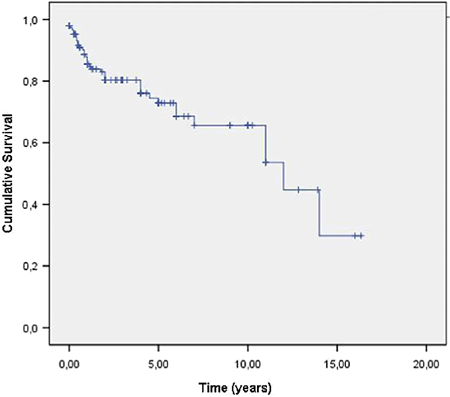ICEECE2012 Poster Presentations Neuroendocrinology (83 abstracts)
Epidemiology, clinical behaviour and prognostic factors of gastroenteropancreatic neuroendocrine tumours in Castilla-La Mancha (Spain) from 1995 to 2010
A. Marco 1 , A. Vicente 1 , L. Lohuibi 2 , M. Alramadan 3 , M. Aguirre 4 , I. Gomez 5 , S. Herranz 6 & C. Roa 4
1Complejo Hospitalario Toledo, Toledo, Spain; 2Hospital General Universitario de Albacete, Albacete, Spain; 3Hospital Virgen de La Luz, Cuenca, Spain; 4Hospital General Universitario de Ciudad Real, Ciudad Real, Spain; 5Hospital General La Mancha Centro, Alcázar de San Juan, Spain; 6Hospital Universitario de Guadalajara, Guadalajara, Spain.
Neuroendocrine gastroenteropancreatic tumours (GEP–NETs) are considered rare malignancies that are characterized by their ability to produce a great variety of peptides that may cause characteristic hormonal syndromes. In this study, we examined the epidemiology, clinical behaviour and prognostic factors of GEP–NETs identified in Castilla La Mancha (Spain) from 1995–2010.
Patients and methods: Two hundred and sixteen patients with GEP–NETs were analyzed in retrospect. Data regarding demographic characteristics, functional syndrome, diagnostic procedures,localization of the primary tumour and stage at diagnosis, therapeutic interventions and survival were collected.
Results: The estimated prevalence was 11.9 cases/1,00,000. 47.7% men, mean age 56.9±18 years, 13% hypersecretion symptoms, 4.6% associated with MEN. No significant differences according to gender were observed. Incidental diagnostic in 47.6% of cases. Computed tomography (69.9%), ultrasound (47.7%) and octreotide scintigraphy (39.8%) were the most commonly imaging studies carried out. Chromogranin A and urinary 5-hydroxyindole acetic acid were done in 41% and 14.3% and were increased in 79.8% and 28.6% of tested patients respectively. Tumour characteristics are expressed in Table 1. Two-thirds of the patients underwent surgery. Local-regional therapies (chemoembolization, radiofrequency or other ablative techniques) were uncommon (<3%). 35.7% received systemic therapy (18.5% somatostatin analogues, 2.3% interferon, 13% chemotherapy).The median overall survival was 12 years, with 72.9% alive at 5 years (95% CI 65.5%–80.32%) and was significantly greater in younger patients, in patients with hormonal syndrome, early stage and lower grade. Prognosis differed according to tumour type and primary tumour site. Multivariate analysis confirmed Ki-67 index as the only independent prognostic factor for survival.
Conclusions: This study provided comprehensive information on the prevalence, management and outcome of this type of tumours from a region of Spain.
Declaration of interest: The authors declare that there is no conflict of interest that could be perceived as prejudicing the impartiality of the research project.
Funding: This research did not receive any specific grant from any funding agency in the public, commercial or not-for-profit sector.
| N=216 | % | |
| Tumour types: Carcinoid Pancreatic non functional NETs Metastasis of unknown primary Insulinoma Gastrinoma Glucagonoma Vipoma | 150 34 8 12 9 1 2 | 69,4 15,7 3,7 5,6 4,2 0,5 0,9 |
| Primary Tumour site: Gastrointestinal tract Pancreas Unknown | 155 52 8 | 72 24 4 |
| Stage at diagnosis: Local Regional Distant Unknown | 129 9 50 28 | 59,6 4,2 23,1 13 |
| Localization of metastasis: Liver Lymph nodes Peritoneum Lung Bone CNS Multiple | 35 19 4 2 1 1 5 | 63,6 15,8 7 3,5 1,8 1,8 8,8 |
| CNS: Central nervous system | ||





